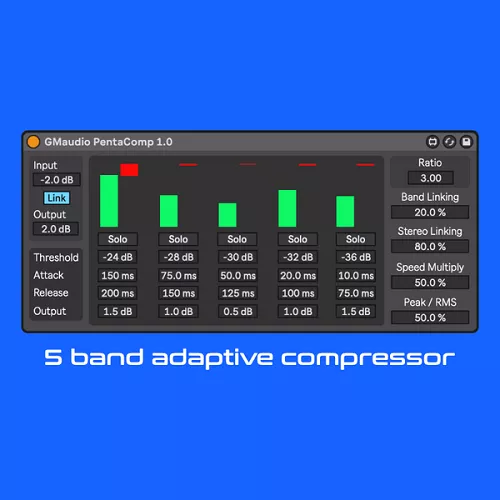Robert K Groov Mekanik GMaudio PentaComp [AMXD]
A compressor from GMaudio has been a long time coming, but it’s not until recently that I felt that I had something unique to offer in terms of dynamics processing. My experience as a mixing and mastering engineer, as well as my explorations into the the world of digital signal processing, has resulted in this device; a program dependant, multi-band compressor with 5 bands that can be used to balance groups, enhance details and reduce masking or squish gnarly sounds to perfection.
The audio is split into 5 bands using a 24dB Linkwitz-Riley, filter network. The crossover frequencies frequencies are fixed at 160hz, 800hz, 4khz & 11khz. This is considered ideal for most material, especially full range signals like groups of instruments or full mixes.
The default preset for this device is a blend of my most used settings for mixing groups/stems and mastering full tracks, requiring very little adjustment for almost any signal. The main parameters are ‘Device Input’, ‘Device Output’, ‘Ratio’, ‘Speed Multiply’ & ‘Peak/RMS’.
Metering is limited to save on CPU and reduce clutter but provides adequate insight into what the processor is doing. The green meters are the input level for each band and are shown in dB. The red meters show gain reduction in absolute amplitude, meaning that approximately half the distance down equates to 6dB of gain reduction and past the mid-point to the bottom is another 64dB of gain reduction. This allows us to see small amounts of gain reduction more easily.
Using the ‘Link’ button you can adjust both the ‘Device Input’ & ‘Device Output’ simultaneously, driving more signal into the device, increasing/decreasing the amount of gain reduction while compensating for the changes in amplitude. The ‘Ratio’ parameter controls the overall amount of gain reduction that can occur.
‘Speed Multiply’ introduces a unique algorithm which speeds up the attack and release times for each band depending on the ratio between peak amplitude and average amplitude, effectively applying more gain reduction to transients and minimising distortion. This is what makes this multi-band compressor, program dependant and adjust itself to the incoming signal.
‘Peak/RMS’ defines whether the device uses peak amplitude or average amplitude for the detection circuit, allowing you to focus gain reduction on catching peaks or minimising changes in perceived loudness.
There are two other important features of this device that help maintain natural compression and improve multi-band processing. They are ‘Band Linking’ & ‘Stereo Linking’. These allow you to control the independence of all 10 compressors (5 bands per Left & Right Channel) which can reduce steering (where the focus is shifted and the integrity of the original signal is lost) and help enhance details in the signal.
The rest of the parameters are your standard compressor settings, but for 5 stereo bands. All bands have a 10dB knee, so they start compressing 5dB below the threshold and reach the ‘Ratio’ 5dB above it. All parameters have Info View text, providing direction for further adjustment if required. Overall the device adds no latency and has very low CPU usage for a plugin of this type. All of the important processing happens in gen~ for efficiency and precision.
Use it to compress your big bass and crazy lead tracks, to balance the frequency content of a group of tracks or on the master as a quick demo mastering preset. Combining this with my Clipper device, another upcoming compressor and a new side-chain tool, mixing gets easier, with better results in less time, meaning you can focus on whats important, The Music!



![Savant 3AM Multi Kit [WAV MIDI Analog Lab Presets]](https://freshstuff4you.com/wp-content/uploads/2025/12/3am-multi-kit-90x90.webp)


